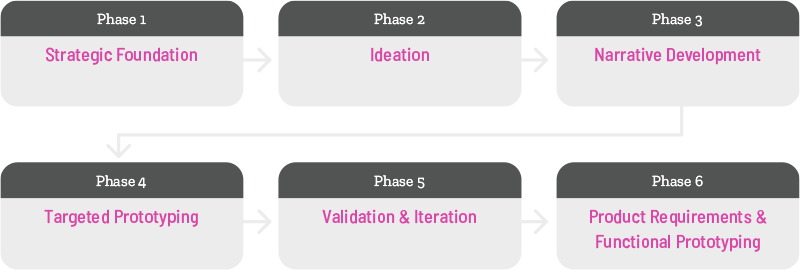EdTech teams should use AI as a strategic multiplier, not an initiator. Start with human-led strategic thinking to define goals and user needs, then use AI tools to enhance ideation, refine concepts, and accelerate prototyping. This approach creates products that solve real problems rather than impressive demos that fail during user testing. The key is following a structured 6-phase process that keeps human expertise at the center of strategic decisions.
In This Article:
- Why Are EdTech Teams Struggling with AI Integration?
- What’s the Hidden Cost of Skipping Strategy?
- What’s the Right Process for AI-Enhanced Product Development?
- How Do You Implement Each Phase Successfully?
- What Principles Should Guide Your AI Integration Strategy?
- How Can Teams Start Implementing This Approach?
- Ready to Implement AI Features That Actually Work?
Why Are EdTech Teams Struggling with AI Integration?
We’re witnessing a troubling pattern across EdTech product teams. Teams are jumping straight into the latest AI prototyping tools, skipping the strategic thinking that makes products actually work for users. The results? Polished-looking prototypes that fail spectacularly when real students and instructors try to use them.
After working with dozens of EdTech companies navigating this challenge, we’ve developed a clear perspective: AI should multiply human expertise, not replace it.
The Rush to Prototype Without Purpose
Picture this: A product team has a vague idea for a new feature. They type a loose prompt into an AI tool, generate a sleek prototype in minutes, and present it to stakeholders who are impressed by how “finished” it looks. Everyone feels productive. The timeline seems accelerated.
We understand these pressures. Stakeholders want progress. Competitors announce AI features daily. The fear of being left behind is real. But there’s a better way that’s actually faster in the long run.
What’s the Hidden Cost of Skipping Strategy?
Reality hits during user testing. The feature doesn’t address actual user needs. It lacks differentiation. Users get dropped into polished interfaces without understanding what problem is being solved. Teams conflate concept testing with usability testing, missing critical strategic decisions while chasing shiny new features.
The ChatGPT Wake-Up Call
Consider what happened when OpenAI made ChatGPT free to all students. Teams building basic AI tutoring features found their products obsolete overnight. The ones that survived had already asked: How do we fit into users’ actual workflows? What creates lasting value beyond one-off assignments? Where do we have unique strengths?
The core issue? Teams are using AI as an initiator — letting it drive strategy and shape product vision — rather than as a multiplier that enhances human thinking.
What’s the Right Process for AI-Enhanced Product Development?
Through our work with EdTech product teams, we’ve refined a six-phase process that puts human expertise at the center of strategic decisions. This tactical process focuses specifically on using AI tools in your day-to-day product development workflow.
This approach is actually faster than jumping straight to AI prototyping because you avoid costly rebuilding cycles when testing reveals fundamental flaws. A few hours of strategic thinking upfront saves weeks of pivoting later.
How Do You Implement Each Phase Successfully?

Phase 1: Strategic Foundation (Human-Led)
In a recent article in the Harvard Business Review titled “Beware the AI Experimentation Trap”, the writers identify a common trap that we see many EdTech product teams stumble into — allowing competitive pressure to implement AI features distract from what’s really important — solving users’ real-world problems.
The authors explain, “While experimentation is good, without a connection to the true business opportunity — e.g., transforming the core to serve existing and new customers — experiments inevitably fall short of hopes and expectations. It sounds obvious, but by framing AI as radical and disruptive we often lose sight of the connection to the most fundamental objective of business: to solve problems for customers.”
Before touching any AI tool, answer four fundamental questions:
- What are you trying to achieve?
- What specific pain point are you solving?
- What makes your solution unique?
- How does this provide value beyond “free and good enough”?
This isn’t busywork. Students already paste assignments into ChatGPT, Claude, and Grammarly. Your differentiator might be instructor integration, progress tracking, or academic integrity — features consumer AI won’t provide.
Phase 2: Ideation (Human + AI Multiplier)
Start with human brainstorming using sticky notes and whiteboards. Generate ideas using tried and true ideation and planning methods. Only then bring in AI to analyze those concepts and suggest additional angles you might have missed.
Feed your top concepts into AI with specific prompts like “What adjacent problems might this solve?” or “What implementation challenges are we overlooking?” Take this feedback with healthy skepticism — it’s meant to push your thinking deeper, not provide answers. Real user research and competitive analysis remain essential. Consider a concentrated ideation workshop to move more quickly.
Phase 3: Narrative Development (Human Strategy + AI Refinement)
Create a specific scenario — think movie storyboard. Show a real user encountering a real problem and how your solution uniquely addresses it.
Feed AI a rough draft of how your concept supports a user, and have it help polish your thoughts into a complete narrative that you can share outside your project team. Create storyboard sketches or screen mockups for each piece of the story. The strategic vision remains human.
Phase 4: Targeted Prototyping (Strategic AI Implementation)
Only now open AI prototyping tools — armed with a refined narrative that gives specific, strategic direction. Build only what’s necessary to validate your hypotheses. Unfocused AI prototyping leads to muddy user feedback and wasted effort.
For a comprehensive overview of methods that will support your narrative development process, check out this resource: A Field Guide to UX Research: How (and why) to craft a customized research plan for your EdTech product.
Phase 5: Validation & Iteration
Don’t test concepts and usability simultaneously. Your first validation should answer three questions only:
- Does this problem resonate strongly enough that users would change their current behavior?
- Is our differentiation clear and compelling compared to free alternatives?
- Would instructors champion this, tolerate it, or resist it?
One technique that works: show users your storyboard narrative in a simple video before building an interactive prototype. If they’re not excited by the story and basic promise, no amount of UI polish will save the product. This approach lets you kill bad ideas in days, not months. Knowing what blend of user research and testing methods is essential for delivering AI features that actually work for users.
Phase 6: Product Requirements & Functional Prototyping
Combine strategic thinking with AI assistance to create comprehensive requirements. Incorporate findings from concept testing. Now build expanded prototypes for usability testing, confident you’re refining the right solution rather than polishing the wrong one.
What Principles Should Guide Your AI Integration Strategy?
How Do You Avoid Common AI Integration Pitfalls?
- Always start with human strategic thinking. Goals, problems, and differentiators come from human insight, not AI generation.
- Use AI as a multiplier, not an initiator. Enhance human ideas rather than replace human thinking.
- Separate concept testing from usability testing. Don’t try to do both simultaneously.
- Build purposefully. Every prototype element should align with specific testing goals.
- Move fast with intention. Speed comes from strategic focus, not skipping steps.
How Can Teams Start Implementing This Approach?
AI tools are amplifiers, not originators. When you start with strong strategic thinking and pedagogical grounding, AI helps you move faster and catch things you might miss. When you start with AI, you get polished mediocrity that fails to solve real problems.
If you’re mandated to make a push to gain more market share, the opportunity to differentiate your product by delivering real impact is especially exciting. Check out our EdTech Growth Series:
- Part 1: Research strategies that build the foundation for expansion
- Part 2: Planning processes to navigate your product’s next evolution
- Part 3: Design collaboration that accelerates development
To learn more about a strategic framework that can help your team deliver AI features that can help you gain a competitive edge by delivering real value to your users, check out our recent ebook: The EdTech Leader’s Guide to AI Implementation: A 5-Stage Framework for Features That Deliver Real Value.
Why Does This Matter More Than Ever?
The EdTech landscape is shifting rapidly. Students have unprecedented access to powerful, free AI tools. Your product needs something more — genuine pedagogical value, instructor integration, learning science principles, and safeguards that ensure academic integrity. These differentiators come from deep understanding of educational contexts, not AI prompts.
Teams that follow this human-first, AI-enhanced approach create products that actually work for users. Those that let AI drive strategy create impressive demos that never achieve product-market fit.
Key Takeaways
- The Problem: EdTech teams are using AI as a strategy initiator rather than a multiplier, leading to polished prototypes that fail user testing
- The Solution: Follow a 6-phase human-first, AI-enhanced process that starts with strategic thinking
- Core Principle: AI should enhance human expertise and accelerate validation, not replace strategic decision-making
- Business Impact: This approach prevents costly rebuilding cycles and creates products that survive in an AI-abundant landscape
- Implementation: Start with clear strategic questions before touching any AI prototyping tools
Ready to Implement AI Features That Actually Work?
Stop wasting time on polished prototypes that fail user testing. Our strategic AI implementation process helps EdTech teams create features that solve real problems and survive in an AI-abundant landscape.
Schedule a free discovery call to learn how Openfield’s human-first, AI-enhanced approach can help your team move faster while avoiding costly rebuilding cycles.
